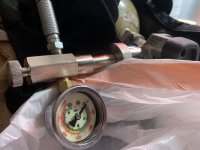First try using my new "6000 PSI" rig to top off my air rifle with this conglomeration hooked up to my Scott 45 minute 4500psi tank. The thread title gives away the result. Gauge popped and spewed when it reached about 3400'ish psi. Glycerin everywhere!
I eased the tank valve open, in the tiniest increments, every few minutes. I also compared rifle and tank gauges every few minutes. Once the "fill station" gauge indicated 3000ish, it seemed to stall. My Air Venturi Avenger is rated for a 4500psi top off. I wanted to get at least 4000 on this first fill. I persisted with tiny twists of the tank valve, but I shortened the intervals. I constantly checked the Avengers reservoir reading against the fill stations while seeing no gain. A few minutes later?....POP/SPEW
Do I need a reliable gauge? Absolutely; and I would love recommendations.
Additionally Id like pneumatic experts opinion on the possibility that the device has restrictions to flow that could prevent gain past 3000? Ridiculous thought maybe, but questions unasked....



I eased the tank valve open, in the tiniest increments, every few minutes. I also compared rifle and tank gauges every few minutes. Once the "fill station" gauge indicated 3000ish, it seemed to stall. My Air Venturi Avenger is rated for a 4500psi top off. I wanted to get at least 4000 on this first fill. I persisted with tiny twists of the tank valve, but I shortened the intervals. I constantly checked the Avengers reservoir reading against the fill stations while seeing no gain. A few minutes later?....POP/SPEW
Do I need a reliable gauge? Absolutely; and I would love recommendations.
Additionally Id like pneumatic experts opinion on the possibility that the device has restrictions to flow that could prevent gain past 3000? Ridiculous thought maybe, but questions unasked....



Last edited: